
Mannus Riedesel
Encyclopedia
Mannus Riedesel was a master builder in the early 18th century in the Counties of Wittgenstein and surrounding areas, now part of the district of Siegen-Wittgenstein
in the state of North Rhine-Westfalen in the Federal Republic of Germany
. At least ten structures that he built are known to exist, and are regarded as jewels of "half-timbered" Fachwerk construction."
He was literate and well-traveled, but nevertheless a subject of the Counts of Sayn-Wittgenstein
. The argument has been made that he was descended from a line of the Riedesel zu Josbach, a once knightly family in Hesse and Westfalen.
Riedesel used a variety of figures, but favored grapes and grapevines as symbols of fertility. Both human- and gargoyle-like faces adorn various structures. They are carved in the wood, as were inscriptions. The name of Mannus Riedesel appears on some, but not all, of his surviving buildings and in a variety of spellings. Today, the inscriptions and other ornamentation are brightly painted.
Perhaps the best known of Riedesel's work is a large, two-winged house in Bad Berleburg
. According to an inscription, the older gabled wing was built by Mannus Riedesel in 1707. The newer wing was built in 1724. Graf Casimir zu Sayn-Wittgenstein ruled the County of Wittgenstein-Berleburg from 1712 to his death in 1741. Under the regency of his mother, Casimir initiated construction of the Ludwigsburg as a residence for his younger brother, Ludwig Francis (1694–1750). The main door to the original house features an angel's head, which in the local folklore is said to represent the young Ludwig. Their mother, Gräfin Hedwig Sophie, moved her residence to the Ludwigsburg in 1725. Later descendants of what was called the line of Sayn-Wittgenstein-Ludwigsburg
became officers in service of the Russian czar, and the house eventually passed out of the family. It is now a private residence and not open to sight-seeing.
It is situated along Odeborn
creek, which flows through the city. The red-and-white Fachwerk is distinctive to the ruling family, as buildings of the time used only black-and-white coloration. The Ludwigsburg is richly decorated with carved ornamentation in the beams and corner posts.
 Another commission from the Count of Wittgenstein-Berleburg was a hunting lodge
Another commission from the Count of Wittgenstein-Berleburg was a hunting lodge
and forester's house not far from Wunderthausen. Dambach was a hamlet in medieval times, but was abandoned by 1500. Evidence of the village can be found in the valley of Dambach creek. In 1711, Mannus Riedesel built the main house. The Count paid for it, but it was occupied by a forester named Georg Wilhelm Stark, and his wife Elisabeth. Hof Dambach is decorated with various runes, figures, and other symbols of peace and fertility. There are other old out-buildings with the property (bakery, horse stall) but they were not built by Mannus Riedesel. Inside the main house, the hallway runs the full length of the house with living and sleeping rooms to the left. The cellar was underneath, where livestock were originally kept. The decorated chamber and hunting room was used for speeches and presentations by the forester, pastors, teachers and others.
Today Hof Dambach is a Pension serving tourists from Germany, the Netherlands, and elsewhere.
The small village of Sassenhausen is the site of a distinctive and still-functional church which Mannus Riedesel built in 1703. Behind the sanctuary is another room which was later built in to serve as a school. Wittgenstein was still recovering from the Thirty Years' War
. The question is raised as to how a small village of only 14 dwellings and perhaps 90 people could afford to engage the best-known builder in Wittgenstein. But Mannus Riedesel had close family ties to Sassenhausen. His younger brothers had godparents from Sassenhausen, and his sister was related by marriage to another master carpenter in Sassenhausen. The Count provided the timber. With two or three journeymen and help from the villagers, the church was completed in the summer of 1703.
One must enter the chapel through a low door that forces one to bow one's head. The altar rails
are inscribed with early deacons of the church. The Counts of Wittgenstein were early converts to the Calvinist or Reformed confession, which they required of most of their subjects.
The house on Königstraße in Bad Laasphe built in c. 1709.
The house at Parkstraße 5 in Bad Berleburg
built in 1725; it was built for a lieutenant in the
Count's small guard contingent who died young; details of the widow's correspondence with the Count asking for help as well as details of the construction costs have been preserved.
The pastor's house in Wingeshausen is believed to be one of his works as well, though it was torn down in 1912.
Siegen-Wittgenstein
Siegen-Wittgenstein is a Kreis in the southeast of North Rhine-Westphalia, Germany. Neighboring districts are Olpe, Hochsauerlandkreis, Waldeck-Frankenberg, Marburg-Biedenkopf, Lahn-Dill, Westerwaldkreis, Altenkirchen.-History:...
in the state of North Rhine-Westfalen in the Federal Republic of Germany
Germany
Germany , officially the Federal Republic of Germany , is a federal parliamentary republic in Europe. The country consists of 16 states while the capital and largest city is Berlin. Germany covers an area of 357,021 km2 and has a largely temperate seasonal climate...
. At least ten structures that he built are known to exist, and are regarded as jewels of "half-timbered" Fachwerk construction."
Personal
Riedesel was born June 6, 1662 at the hamlet of Melbach/Balde to Heyrich and Gerthrut (Dickel) Riedesel, the first of at least five children. He was christened Johann Mannus, though he is generally known as Mannus. Even so, he signed himself as "Hermannus" on occasion and (like most of the world) even spelled Riedesel in various fashions. He married for the first time in 1687 to Anna Ursula Spies with whom he had at least two children. Following her death, he married again to Anna Katherine Grund in 1693, and they had three known children. His death is recorded at the Melbach on November 4, 1726.He was literate and well-traveled, but nevertheless a subject of the Counts of Sayn-Wittgenstein
Sayn-Wittgenstein
Sayn-Wittgenstein was a county of mediæval Germany, located in the Sauerland of eastern North Rhine-Westphalia. Sayn-Wittgenstein was created when Count Salentin of Sayn-Homburg married the heiress Countess Adelaide of Wittgenstein in 1345...
. The argument has been made that he was descended from a line of the Riedesel zu Josbach, a once knightly family in Hesse and Westfalen.
Riedesel used a variety of figures, but favored grapes and grapevines as symbols of fertility. Both human- and gargoyle-like faces adorn various structures. They are carved in the wood, as were inscriptions. The name of Mannus Riedesel appears on some, but not all, of his surviving buildings and in a variety of spellings. Today, the inscriptions and other ornamentation are brightly painted.
Ludwigsburg
 |  | 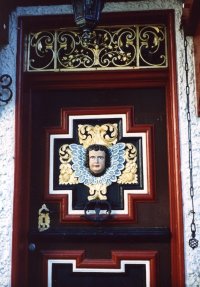 |
Perhaps the best known of Riedesel's work is a large, two-winged house in Bad Berleburg
Bad Berleburg
Bad Berleburg is a town, in the district of Siegen-Wittgenstein, in North Rhine-Westphalia, Germany. It is one of Germany's largest towns by land area. It is located approx...
. According to an inscription, the older gabled wing was built by Mannus Riedesel in 1707. The newer wing was built in 1724. Graf Casimir zu Sayn-Wittgenstein ruled the County of Wittgenstein-Berleburg from 1712 to his death in 1741. Under the regency of his mother, Casimir initiated construction of the Ludwigsburg as a residence for his younger brother, Ludwig Francis (1694–1750). The main door to the original house features an angel's head, which in the local folklore is said to represent the young Ludwig. Their mother, Gräfin Hedwig Sophie, moved her residence to the Ludwigsburg in 1725. Later descendants of what was called the line of Sayn-Wittgenstein-Ludwigsburg
Sayn-Wittgenstein-Ludwigsburg
Sayn-Wittgenstein-Ludwigsburg was a side line of the Sayn-Wittgenstein-Berleburg family, created by Graf Casimir for his brother, Ludwig Francis zu Sayn-Wittgenstein-Berleburg...
became officers in service of the Russian czar, and the house eventually passed out of the family. It is now a private residence and not open to sight-seeing.
It is situated along Odeborn
Odeborn
Odeborn is a river of North Rhine-Westphalia, Germany.-See also:*List of rivers of North Rhine-Westphalia...
creek, which flows through the city. The red-and-white Fachwerk is distinctive to the ruling family, as buildings of the time used only black-and-white coloration. The Ludwigsburg is richly decorated with carved ornamentation in the beams and corner posts.
Hof Dambach

Hunting
Hunting is the practice of pursuing any living thing, usually wildlife, for food, recreation, or trade. In present-day use, the term refers to lawful hunting, as distinguished from poaching, which is the killing, trapping or capture of the hunted species contrary to applicable law...
and forester's house not far from Wunderthausen. Dambach was a hamlet in medieval times, but was abandoned by 1500. Evidence of the village can be found in the valley of Dambach creek. In 1711, Mannus Riedesel built the main house. The Count paid for it, but it was occupied by a forester named Georg Wilhelm Stark, and his wife Elisabeth. Hof Dambach is decorated with various runes, figures, and other symbols of peace and fertility. There are other old out-buildings with the property (bakery, horse stall) but they were not built by Mannus Riedesel. Inside the main house, the hallway runs the full length of the house with living and sleeping rooms to the left. The cellar was underneath, where livestock were originally kept. The decorated chamber and hunting room was used for speeches and presentations by the forester, pastors, teachers and others.
Today Hof Dambach is a Pension serving tourists from Germany, the Netherlands, and elsewhere.
Schulkapelle in Sassenhausen
 | 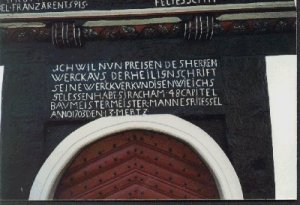 |
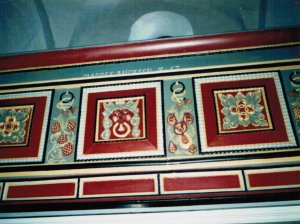 |
The small village of Sassenhausen is the site of a distinctive and still-functional church which Mannus Riedesel built in 1703. Behind the sanctuary is another room which was later built in to serve as a school. Wittgenstein was still recovering from the Thirty Years' War
Thirty Years' War
The Thirty Years' War was fought primarily in what is now Germany, and at various points involved most countries in Europe. It was one of the most destructive conflicts in European history....
. The question is raised as to how a small village of only 14 dwellings and perhaps 90 people could afford to engage the best-known builder in Wittgenstein. But Mannus Riedesel had close family ties to Sassenhausen. His younger brothers had godparents from Sassenhausen, and his sister was related by marriage to another master carpenter in Sassenhausen. The Count provided the timber. With two or three journeymen and help from the villagers, the church was completed in the summer of 1703.
One must enter the chapel through a low door that forces one to bow one's head. The altar rails
Altar rails
Altar rails are a set of railings, sometimes ornate and frequently of marble or wood, delimiting the chancel in a church, the part of the sanctuary that contains the altar. A gate at the centre divides the line into two parts. The sanctuary is a figure of heaven, into which entry is not guaranteed...
are inscribed with early deacons of the church. The Counts of Wittgenstein were early converts to the Calvinist or Reformed confession, which they required of most of their subjects.
Lotzes/Fuch'ses in Wunderthausen
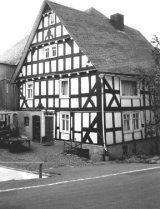 | The last house known to have been built by Mannus Riedesel sits on the main road through Wunderthausen. It was erected in 1726, the same year he died. Little detail is known of its construction. Lotzes is one of three old Fachwerk houses that survived the fires of the late 19th century. |
Stoltz'sches house in Laasphe
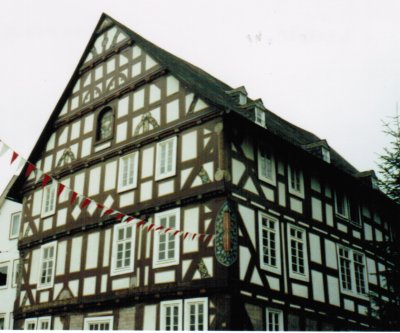 | This is another grand town home built in 1705. Though not as large as the Ludwigsburg, it towers over the street. The corner posts are richly decorated in Mannus Riedesel's usual style. It was built for the wealthy brewer and distiller Joh. Adam Stoltz and his wife, Anna Elisabeth. It is said to have been the first house built outside the town gates. |
Hain-Hof in Puderbach
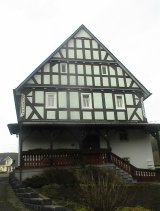 | Hain-Hof, a large farmhouse in Puderbach at Eschenstraße 6 built in 1712. |
Others
The barn built in 1702 at his home in the Melbach; some of the beams are richly decorated (not readily accessible to the public, as it is privately owned).The house on Königstraße in Bad Laasphe built in c. 1709.
The house at Parkstraße 5 in Bad Berleburg
Bad Berleburg
Bad Berleburg is a town, in the district of Siegen-Wittgenstein, in North Rhine-Westphalia, Germany. It is one of Germany's largest towns by land area. It is located approx...
built in 1725; it was built for a lieutenant in the
Count's small guard contingent who died young; details of the widow's correspondence with the Count asking for help as well as details of the construction costs have been preserved.
The pastor's house in Wingeshausen is believed to be one of his works as well, though it was torn down in 1912.

